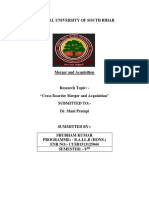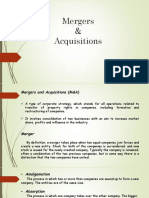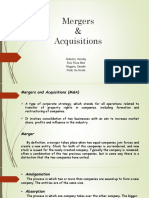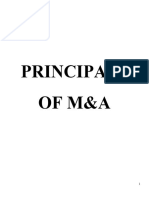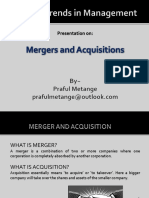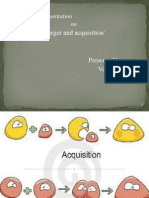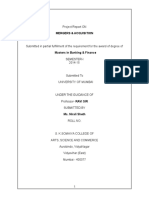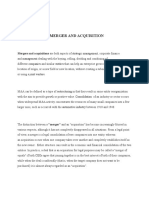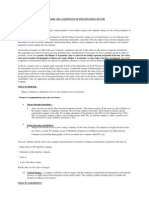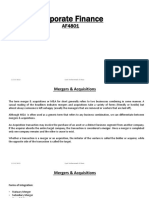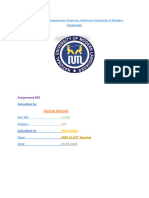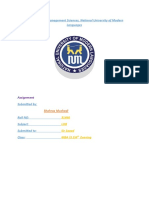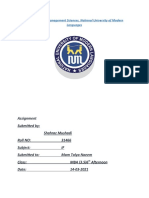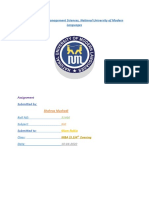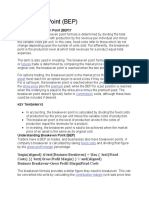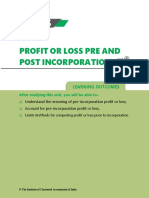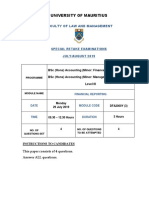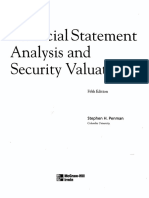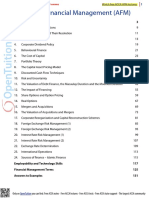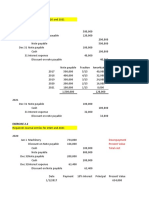Department of Management Sciences, National University of Modern
Languages
Assignment
Submitted by:
Shahraz Mushadi
Roll NO: 31466
Subject: M&A
Submitted to: Sir Rao Akmal
Class: MBA (3.5)5th
Date: 02-10-2020
�Summary:
Chapter #01
Merger
A merger is an agreement that unites two existing companies into one new
company.
A statutory merger takes place when one company completely absorbs
another company, and the absorbed company is no longer a legal entity.
A subsidiary merger is a type of merger that occurs when the acquiring
company uses its subsidiary company to acquire a target company.
Subsidiary company is a company that is owned or controlled by another
company, which is called the parent company, parent, or holding company.
Forward triangular merger is the acquisition of a company by a subsidiary
of the purchasing company.
Reverse triangular merger is the formation of a new company that occurs
when an acquiring company creates a subsidiary, the subsidiary purchases
the target company, and the subsidiary is then absorbed by the target
company.
Consolidation is a business combination whereby two or more companies
join to form an entirely new company. All of the combining companies are
dissolved and only the new entity continues to operate.
VALUING A TRANSACTION
Enterprise value is defined as the base equity price plus the value of the target’s
debt and preferred stock less its cash. The base equity price is the total price less
the value of the debt.
TYPES OF MERGERS
A horizontal merger occurs when two competitors combine.
Vertical mergers are combinations of companies that have a buyer-seller
relationship.
A conglomerate merger occurs when the companies are not competitors
and do not have a buyer-seller relationship.
REASONS FOR MERGERS AND ACQUISITIONS
� Value creation. Two companies may undertake a merger to increase the
wealth of their shareholders.
Diversification.
Acquisition of assets.
Increase in financial capacity.
Tax purposes.
Incentives for managers.
MERGER CONSIDERATION
Mergers may be paid for in several ways. Transactions may use all cash, all
securities, or a combination of cash and securities. Securities transactions
may use the stock of the acquirer as well as other securities such as
debentures.
If a bidder offers its stock in exchange for the target’s shares, this offer may
provide for either a fixed or floating exchange ratio.
pricing When the exchange ratio is floating, the bidder offers a dollar value
of shares as opposed to a specific number of shares. The number of shares
that is eventually purchased by the bidder is determined by dividing the
value offered by the bidder’s average stock price during a prespecified
period.
‘‘collar’’ it provides for a maximum and minimum number of shares within
the floating value agreement.
Contingent Value Rights are rights granted by an acquirer to a company’s
shareholders, facilitating the transaction where some uncertainty is
inherent.
The contingent value rights guarantee some future value if the acquirer’s
shares that were given in exchange for the target’s shares fall below some
agreed upon threshold.
MERGER PROFESSIONALS
When a company decides it wants to acquire or merge with another firm, it
typically does so using the services of attorneys, accountants, and valuation
experts.
� For smaller deals involving closely held companies, the selling firm may
employ a business broker who may represent the seller in marketing the
company.
In larger deals involving publicly held companies, the sellers and the buyers
may employ investment bankers.
Investment bankers may provide a variety of services, including helping to
select the appropriate target, valuing the target, advising on strategy, and
raising the requisite financing to complete the transactions.
Investment banks derive fees in various ways from M&As. They may receive
advisory fees for their expertise in structuring the deal and handling the
strategy—especially in hostile bids.
The intermediaries who work on smaller deals are usually not investment
banks but are business brokers.
Given the complex legal environment that surrounds M&As, attorneys also
play a key role in a successful acquisition process.
MERGER ARBITRAGE
Arbitrage refers to the buying of an asset in one market and selling it in
another.
It is an investment strategy that speculates on the successful completion of
mergers and acquisitions.
LEVERAGED BUYOUTS AND THE PRIVATE EQUITY MARKET
A leveraged buyout is one company's acquisition of another company using
a significant amount of borrowed money to meet the cost of acquisition.
management buyout, the buyer of a company, or a division of a company, is
the manager of the entity.
CORPORATE RESTRUCTURING
It reorganizing the legal, ownership, operational, or other structures of a company
for the purpose of making it more profitable, or better organized for its present
needs.
MERGE AR NEGOTIATIONS
�A negotiation process conducted for the merger or joining of two companies into
a single business entity, or the outright purchase of a company by another
company.
Initial Agreement
When the parties have reached the stage where there are clear terms upon which
the buyer is prepared to make an offer which it thinks the seller may accept, the
buyer prepares a term sheet.
DISCLOSURE OF MERGER NEGOTIATIONS
STRUCTURING THE DEAL
Most deals employ a triangular structure utilizing a subsidiary corporation that is
created by the buyer to facilitate the acquisition of the target.
MERGER AGREEMENT
A merger agreement is the legal contract that is drawn up and signed by both
parties when two companies merge. Its terms and conditions can be quite
detailed, and it usually spells out several parameters regarding staffing actions to
be implemented.
MERGER APPROVAL PROCEDURES
Board of directors of each company reaches an agreement, they adopt a
resolution approving the deal.
This resolution should include:
the names of the companies involved in the deal and the name of
the new company
financial terms
convert securities of each company into securities of the surviving
corporation
the articles of incorporation
SPECIAL COMMITTEES OF THE BOARD OF DIRECTORS
�The board of directors may choose to form a special committee of the board to
evaluate the merger proposal. Directors who might personally benefit from the
merger, such as when the buyout proposal contains provisions that management
directors may potentially profit from the deal, should not be members of this
committee.
FAIRNESS OPINIONS
VOTING APPROVAL
DEAL CLOSING
SHORT-FORM MERGER
A short-form merger may take place in situations in which the stockholder
approval process is not necessary. Stockholder approval may be bypassed when
the corporation’s stock is concentrated in the hands of a small group, such as
management, which is advocating the merger.
FREEZEOUTS AND THE TREATMENT OF MINORITY SHAREHOLDERS
A majority of shareholders must provide their approval before a merger can be
completed. A 51% margin is a common majority threshold. When this majority
approves the deal, minority shareholders are required to tender their shares, even
though they did not vote in favor of the deal.
PURCHASE OF ASSETS COMPARED WITH PURCHASE OF STOCK
ASSUMPTION OF THE SELLER’S LIABILITIES
ADVANTAGES OF ASSET ACQUISITIONS
tax advantage
limited liabilities
Minority shareholders
ASSET SELLOFFS
�When a corporation chooses to sell off all its assets to another company, it
becomes a corporate shell with cash and or securities as its sole assets. The firm
may then decide to distribute the cash to its stockholders as a liquidating dividend
and go out of existence.
REVERSE MERGERS
A reverse merger is a merger in which a private company becomes a public
company by acquiring it. It saves a private company from the complicated process
and expensive compliance of becoming a public company.
SPECIAL PURCHASE ACQUISITION VEHICLES
Special purchase acquisition vehicles (SPACs) are companies that raise capital in
an IPO where the funds are earmarked for acquisitions. They are sometimes also
referred to as blank check companies or cash-shells.
HOLDING COMPANIES
A holding company is a company that owns the outstanding stock of other
companies. A holding company usually does not produce goods or services itself.
Its purpose is to own shares of other companies to form a corporate group.
ADVANTAGES
Lower cost
No control premium
Control with fractional ownership
Approval not required
DISADVANTAGES
Multiple taxation
Antitrust issues
Lack of 100% ownership














